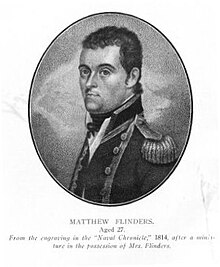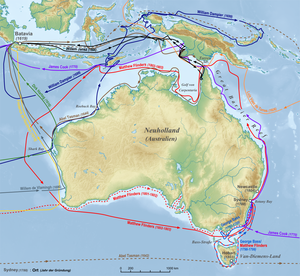Matthew Flinders
Matthew Flinders (born March 16, 1774 in Donington , Lincolnshire , England , † July 19, 1814 in London ) was a British explorer .
Life
Inspired by reading Daniel Defoe's Robinson Crusoe , Matthew Flinders had an early desire to go to sea. In 1789 Matthew Flinders joined the Royal Navy and sailed 1791-1793 with Captain William Bligh on the Providence in the Pacific. Matthew Flinders was mentored and promoted by Joseph Banks , who played a key role in the preparation of the two expeditions.
In 1795, as a midshipman , Flinders accompanied the naval doctor George Bass on his journey to the southeast coast of Australia and in 1798 explored the islands at the east entrance of the Bass Strait . With Bass he crossed the street named after him and circled Tasmania .
On a new voyage of discovery in 1801 with his ship Investigator , Flinders followed the south coast of Australia from Cape Leeuwin to the Bass Strait and discovered the Spencer Gulf and the St. Vincent Gulf . He was accompanied on this trip by the botanist Robert Brown and, as a midshipman, his nephew John Franklin , who was twelve years his junior and who later became the rear admiral and polar explorer. The botanical draftsman Ferdinand Bauer accompanied him and made a total of 2073 drawings. Bungaree , an elder of the Aborigines , also served as an interpreter and mediator. On April 8, 1802, Flinders met in Encounter Bay with the French research expedition led by Nicolas Baudin . In the same year, Flinders also explored Australia's east coast from Port Stephens to Cape Palmerston and the Great Barrier Reef . On this voyage of discovery he found the entrance to Port Phillip Bay , which John Murray had recently sighted. In Torres Strait he discovered the only safe passage in the north of Prince Wales Island . Flinders was the first to completely circumnavigate Australia.
On the way back from Sydney to England, Flinders had to call at the then still French island of Mauritius (Île de France) because of the poor condition of his ship Cumberland . Despite a letter of safe conduct from the French government, the island's governor, Charles Matthieu Isidore Decaen , had the ship confiscated and Flinders captured. He also ignored requests from the French government to release Flinders. It was not until a British blockade in 1810 that after six years and five months imprisonment, he was released. In October of the same year Flinders reached London and was subsequently promoted to post-captain , which in this case corresponded to a current frigate captain .
Flinders invented a tool to reduce the influence of the ship's iron on the compass needle: the so-called Flinders rod, a vertical iron rod or a vertical iron tube in front of the compass . In 1804 he was the first to suggest Australia as the name for the new continent , in memory of the fabulous southern land sought for centuries, the Terra Australis . This designation quickly replaced the name Neuholland, which had been in use until then .
His only daughter Anne (1812-1892), who emerged from his marriage to Ann Chappelle, married the surveyor and inventor William Petrie and became the mother of the eminent Egyptologist William Matthew Flinders Petrie .
Flinders was buried in St James's Garden Cemetery in London on July 23, 1814 . However, just a few decades later, his tombstone, along with many others, was removed when the cemetery was redesigned. As early as 1852 his grave could no longer be found by his relatives either. His grave was rediscovered in January 2019 during archaeological excavation work on the area of the then cemetery in connection with the construction of the High Speed 2 express railway line . The assignment was clearly possible due to a labeled lead badge on his coffin.
Named after Flinders
Several geographic objects and authorities in Australia are named after Matthew Flinders, including the river Flinders River , the administrative area Flinders Shire and the highway Flinders Highway in the state of Queensland , the mountain Flinders Ranges ( German Flinders Ranges ) and another highway called Flinders Highway in the state of South Australia as well as the offshore island of Flinders Island from Tasmania . In the major cities of Adelaide and Melbourne , major streets in their respective city centers are named after Flinders; as does Flinders University in Adelaide. After the Flinders Street in Melbourne also one of the two largest railway stations in the city is named, the emblematic Flinders Street Station .
Outside Australia, Flinders Peak , a mountain in Antarctica, is named after him.
Works
- A Voyage to Terra Australis, with an accompanying Atlas. 2 volumes. G&W Nicol, London 18th July 1814 (one day before Flinder's death) picture text
- German language edition
- Matthew Flinders: Journey to the Austral country with the intention of completing the discovery of the same, undertaken in 1801, 1802 and 1803. Translated from the English by Ferdinand Götze. Weimar published by the Landes-Industrie-Comptoirs publishing house in 1816. (sometimes inappropriately shortened and with weaknesses in the translation)
- Matthew Flinders: The first circumnavigation of Australia. After the first German edition by Ferdinand Götze, re-edited by Wolf-Dieter Grün. Edition Erdmann; Stuttgart 1984. ISBN 3-86503-217-6 . (further shortened compared to the original, only added in a few places after the English original edition)
reception
- Ernestine Hill: My love has to wait . Wilhelm Köhler Verlag, Minden - Roman, title of the original English edition: My Love Must Wait. published by Angus & Robertson, London.
- Sten Nadolny : The discovery of slowness . (Paperback). Piper Verlag, 1987, ISBN 3-492-20700-6
- The comic magazine Mosaik covers in issues 430 to 446 (10 / 2011–02 / 2013) the fictional adventures of the Abrafaxe while circumnavigating Australia on the Investigator with Matthew Flinders.
literature
- Ernest Scott : The Life of Captain Matthew Flinders, RN: Angus & Robertson, Sydney 1914
- Geoffrey Rawson: Matthew Flinders' Narrative of his Voyage in the Schooner Francis 1798, preceded and followed by notes on Flinders, Bass, the wreck of the Sidney Cove, & c. - Golden Cockerel Press, London 1946
- Sidney J. Baker: My Own Destroyer: a biography of Matthew Flinders, explorer and navigator . Currawong Publishing Company, Sydney 1962
- KA Austin: The Voyage of the Investigator, 1801-1803, Commander Matthew Flinders, RN Rigby Limited, Adelaide 1964
- James D. Mack: Matthew Flinders 1774-1814. Nelson, Melbourne 1966
- Geoffrey C. Ingleton: Matthew Flinders: navigator and chartmaker . - Guilford, Surrey: Genesis Publications in association with Hedley Australia, 1986
- Tim Flannery : Matthew Flinders' Great Adventures in the Circumnavigation of Australia Terra Australis . - Melbourne: Text Publishing Company, 2001. - ISBN 1-876485-92-2
- Miriam Estensen: Matthew Flinders: The Life of Matthew Flinders . Allen & Unwin, Crows Nest, NSW 2002. ISBN 1-86508-515-4
- Walter Krämer (ed.): The discovery and exploration of the earth. Brockhaus Verlag , Leipzig 1976
- Rudi Palla : The captain and the artist. Exploring the Terra Australis . DuMont Buchverlag, Cologne 2013, ISBN 978-3-8321-9729-2 (about the life of M. Flinders and Ferdinand Bauer and their circumnavigation of Australia together 1801-1803).
- Kenneth Morgan: Matthew Flinders. Maritime Explorer of Australia , New York: Continuum 2016, ISBN 978-1-4411-7962-3 .

effect
- The Flinders Mountains in Australia are named after Matthew Flinders .
- The largest of the Furneaux Islands is named after him, see Flinders Island , Tasmania .
- Robert Brown (1773-1858) named the tree genus Flindersia after him .
See also
Individual evidence
- ↑ Matthew Flinders: Australia explorer's remains found in HS2 dig. BBC News, January 25, 2019, accessed January 25, 2019 .
- ↑ Lost grave discovered by British explorer while building a railway line
Web links
- Literature by and about Matthew Flinders in the catalog of the German National Library
- Matthew Flinders Collection of the State Library of New South Wales 1403 titles (2009)
- The Flinders papers Transcripts of around 150 documents, National Maritime Museum website
- The journey to the Austral-Lande in the original from 1816 scanned (Weimar im Verlag des Landes-Industrie-Comptoirs, 1816)
- Genealogy Matthew Flinders
- Australian Dictionary of Biography
- 1801: MF Observations on the Coasts of Van Diemen's Land on Bass's Strait and its Islands ...
| personal data | |
|---|---|
| SURNAME | Flinders, Matthew |
| BRIEF DESCRIPTION | British explorer |
| DATE OF BIRTH | March 16, 1774 |
| PLACE OF BIRTH | Donington , Lincolnshire, England |
| DATE OF DEATH | July 19, 1814 |
| Place of death | London , England |

